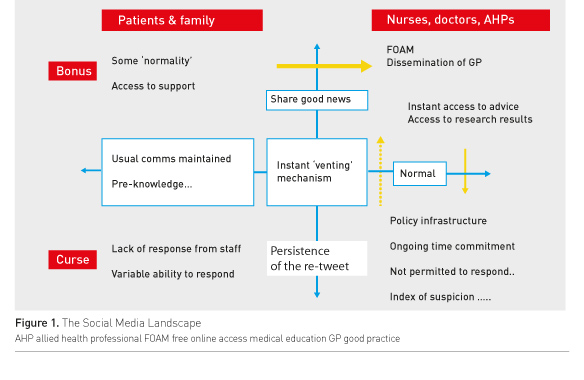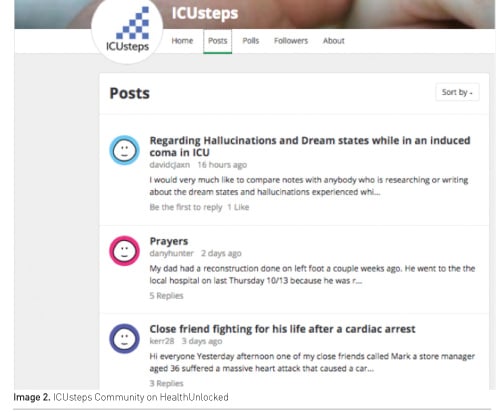ICU Management & Practice, Volume 16 - Issue 4, 2016
Social Media in the “Real” World Social media is all around us, and enables real-time communication with patients, families and with colleagues. There are general social networks (Facebook), professional networks (LinkedIn), blogs (WordPress), microblogs (Tumblr) and media sharing sites for photos, videos and podcasts. The Wall Street fortunes of these companies may wax and wane along with usage, but as health professionals we need to be aware of their benefits, costs and risks.
Do we stop to think how we are using social media? Social media can be cathartic (letting off steam), therapeutic (making sense of experiences), a last resort (e.g. complaints), just routine (Image 1), or “discouragingly daunting” (Widmer and Larsen 2016). Social media can be disinhibiting (think before you post), and true anonymity is virtually impossible to guarantee. Health professionals who might think twice when contacted by a newspaper reporter, for example, may be less inhibited when commenting on social media (media vs social media).
The social media landscape is summarized in Figure 1. It can be a bonus or curse both to patients and to health professionals.


Social
Media Guidance
Many professional organisations have guidelines for their members on social media use. For example, the UK Nursing and Midwifery Council’s social media guidance, a supplement to its professional standards, covers the need to use social media and social networking sites responsibly (Nursing and Midwifery Council 2015). For doctors, the General Medical Council (UK) issued Doctors’ use of social media in 2013. The UK National Health Service (NHS) Employers organisations advocates a liberal approach:
The NHS Employers organisation firmly believes in a permissive approach to using social media in the NHS. Individual staff should be permitted and enabled to use social media for work. Only a permissive approach will unlock the innovations within the vibrant creative spaces found on social media sites (NHS Employers 2014)
Professional guidance is also supplemented by local organisational policies. These can be quite detailed, e.g. Salisbury NHS Foundation Trust’s social media policy and guidance (Salisbury NHS Trust 2015) (sample: “Do not post, upload, forward or post a link to chain mail, junk mail, cartoons, jokes or gossip”). Clinical departmental social media use needs to have full consideration and commitment. For example, East Cheshire NHS Trusts asks that departments wanting to set up a social media site explain how they will manage the risks as well as outline the benefits (East Cheshire NHS Trust 2015).
Patients and Families
Social media use amongst patients and families ranges from routine communication, for example by patients during their ICU stay through to peer-to-peer support. The UK intensive care patient support charity ICUsteps has a peer-to-peer online community with more than 860 members on HealthUnlocked, which is a social network for health (healthunlocked. com/icusteps) (Image 2).
One writer even live-tweeted his mother’s death in an ICU, with his tweets reflecting on the medical care taking place as well as his relationship with his mother (O’Rourke 2015). Social media can also be used for crowdfunding, with many examples on popular websites such as justgiving.com and gofundme.com.
Education
Social media can be educational, and the Free Open Access Medical (FOAM) education movement (foameducation.org) has grown immensely, offering excellent resources for continuing professional development. It includes FOAMcc (FOAM critical care), #FOANed (free open access nursing education) and #FOAMrn (FOAM nursing). For health professionals there are also peer support groups and closed sites that offer crowdsourced answers to clinical problems. Caution must be exercised, however, with the quality of information disseminated. Carroll and colleagues note that ego may outweigh talent: “well-informed participants with important ideas must be strong self-promoters or risk their voices going unheard” (Carroll et al. 2016).
The UK Nursing and Midwifery Council explains the benefits for building professional relationships, accessing support networks and discussing issues with fellow professionals around the world (Nursing and Midwifery Council 2015). The Royal College of Nursing (UK) offers advice on using social media to revalidate, for example by participating in Twitter chats (Royal College of Nursing 2016).

Evidence Dissemination
Social media enables rapid dissemination of evidence, both from scientific meetings and from peer-reviewed journals. This rapid dissemination has a different sort of impact to thorough reading of the literature. It allows harder-hitting recommendations (Young et al. 2013), and permits dissemination of the paper plus “the story”, e.g. 10 reasons to…However, there is a danger of premature dissemination without an accompanying ‘cautionary editorial’.
The growth in tweeting at conferences and in educational use has been analysed in the literature (a list is provided on Symplur symplur. com/healthcare-social-media-research). Even if you cannot attend a meeting or sessions are not streamed, it is possible to participate in social media discussions remotely (Widmer and Larson 2016). Attai and colleagues (2016) suggest that “medical conference organizers should encourage Twitter participation and should be educating attendees on the proper use of Twitter.” Many large meetings have large screens showing the congress Twitter feed, as delegates and remote participants use the hashtag to comment, tweet and re-tweet (Stiegler 016).
Conclusion
So is social media a blessing or a curse? It is neither. It is a change that has to inform our practice. Healthcare organisations need policies in place so that staff know how to respond, and have the time commitment needed if necessary. Health professionals need to accept and plan for social media usage, collaborate, set boundaries and devise protocols for its use, and above all make it work for them.
Recommended
Resources
NHS Employers Social Media resources (includes guide for HR, running social media campaigns, best practice in social media measurement and evaluation, guide for chief executives) nhsemployers.org/your-workforce/need-to-know/social-media-and-thenhs/social-media-publications
Twitter chats
wecommunities.org/tweet-chats/chat-guide
References:
Attai DJ, Radford DM, Cowher MS (2016) Tweeting the meeting: Twitter use at the American Society of Breast Surgeons annual meeting 2013-2016. Ann Surg Oncol, 23(10): 3418-22.
PubMed ↗
Carroll CL, Bruno K, vonTschudi M (2016) Social media and free open access medical education: the future of medical and nursing education? Am J Crit Care, 25(1): 93-6.
Article ↗
East Cheshire NHS Trust (2015) Social media policy. [Accessed: 4 November 2016] Available from eastcheshire.nhs.uk/About-The-Trust/policies/S/Social%20Media%20Policy%20ECT2295.pdf
General Medical Council (2013) Doctors’ use of social media. [Accessed: 4 November 2016] Available from gmc-uk.org/guidance/ethical_guidance/21186.asp
NHS Employers (2014) New to the NHS? Your guide to using social media in the NHS. [Accessed: 4 November 2016] Available from nhsemployers.org/case-studies-and-resources/2014/11/new-to-the-nhs-your-guide-to-using-social-media
Nursing and Midwifery Council (2015) Guidance on using social media responsibly. [Accessed: 4 November 2016] Available from nmc.org.uk/standards/guidance/social-media-guidance
O’Rourke M (2013) Tweeting death. New Yorker, 31 July. [Accessed: 20 October 2016] Available from newyorker.com/culture/culture-desk/tweeting-death
Royal College of Nursing (2016) How social media can help you revalidate. [Accessed: 4 November 2016] Available from rcn.org.uk/professional-development/revalidation/how-social-media-can-help-you-revalidate
Salisbury NHS Foundation Trust (2015) Social media policy & guidance. [Accessed: 4 November 2016] Available from salisbury.nhs.uk/AboutUs/OurPoliciesAndProcudures/Pages/SocialMediaPolicyGuidance.aspx
Stiegler M (2016) Twitter for busy doctors: tweeting the meeting. [Accessed: 4 November 2016] Available from marjoriestieglermd.com/twitter-for-busy-doctors-tweeting-the-meeting
Widmer RJ, Larsen CM 92016) Call for FITs/ECs to become engaged with social media. J Am Coll Cardiol, 68(4): 422-5.
Article ↗
Young PJ, Nickson CP, Gantner DC (2013) Can social media bridge the gap between research and practice? Crit Care Resusc, 15(4): 257-9.
PubMed ↗




















